You are using an out of date browser. It may not display this or other websites correctly.
You should upgrade or use an alternative browser.
You should upgrade or use an alternative browser.
Barn Door for JK factory hardtops
- Thread starter jscherb
- Start date
jscherb
Expedition Leader
Excellent idea! And just a few minutes ago I got a marketing email from MPJA, one of my favorite surplus electronic components suppliers, and this submersible pump is on sale - just drop it in the reservoir?Even more interesting, if you control the extra pump with the Auxbeam controler!

12VDC Submersible Water Pump
Submersible Brushless DC impeller pump for lab equipment, sampling inst. etc. In or under tank mounting. NOT SELF PRIMING Power: 12VDC @ .36A Dry Output Port: 12mm O/D Hose Input: 17mm O/D Rated: ~360 GPH Head: ~2m Plastic pump body. 6 leads
www.mpja.com

jscherb
Expedition Leader
I got a text from MORryde a week before Christmas, they asked if I would install an Overhead Lockbox in my JKU and take photos of the installation process for an updated set of installation instructions - they don't have a JKU at their disposal, they've only got a JLU. Since I designed the Lockbox a few years ago, of course I agreed. A large package arrived a few days later:
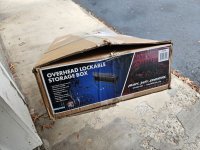
I installed it, took photos of the process, wrote some suggested edits for the draft instructions, and sent the photos and edits to MORryde. Here are a few photos. It mounts to the roll bars and stows up against the inside of the hardtop and swings down for access. I've attached a few photos of it stowed and just barely visible above the cargo space, swung down and swung down and open. Fits '07-'18 Wrangler Unlimited. It's a great way to add some secure storage to a Wrangler, and it stows above the cargo area in space that never gets used.
Stowed and just barely visible:
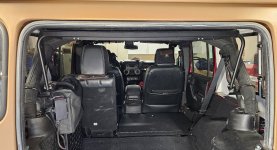
Swung down:
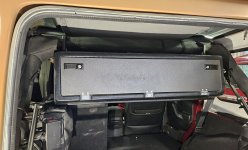
Swung down and open:
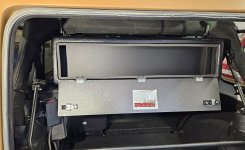
When I sent the photos and edits to MORryde I asked them what I should do with the product now that I'm done the photos. I don't need it because I use the Overhead MOLLE panel (basically the same product but instead of the lockbox it's got a MOLLE panel and no box). Not only do I not need it, I don't feel like moving it to the new house when we move in a few months.
They suggested I offer it to forum members at a discount - it sells for between $385 and $425 (links below) so if anyone is interested they can have it for $200 or best offer and I will donate the money to the local Food Bank. MORryde says they will cover shipping from me to the buyer.
Links to the product: https://www.extremeterrain.com/morryde-xtw-overhead-flip-down-lock-box-jp54-070.html ($384.99) and https://www.quadratec.com/p/morryde/flip-down-lock-box-wrangler-jk-jp54-070 ($425.99).

I installed it, took photos of the process, wrote some suggested edits for the draft instructions, and sent the photos and edits to MORryde. Here are a few photos. It mounts to the roll bars and stows up against the inside of the hardtop and swings down for access. I've attached a few photos of it stowed and just barely visible above the cargo space, swung down and swung down and open. Fits '07-'18 Wrangler Unlimited. It's a great way to add some secure storage to a Wrangler, and it stows above the cargo area in space that never gets used.
Stowed and just barely visible:

Swung down:

Swung down and open:

When I sent the photos and edits to MORryde I asked them what I should do with the product now that I'm done the photos. I don't need it because I use the Overhead MOLLE panel (basically the same product but instead of the lockbox it's got a MOLLE panel and no box). Not only do I not need it, I don't feel like moving it to the new house when we move in a few months.
They suggested I offer it to forum members at a discount - it sells for between $385 and $425 (links below) so if anyone is interested they can have it for $200 or best offer and I will donate the money to the local Food Bank. MORryde says they will cover shipping from me to the buyer.
Links to the product: https://www.extremeterrain.com/morryde-xtw-overhead-flip-down-lock-box-jp54-070.html ($384.99) and https://www.quadratec.com/p/morryde/flip-down-lock-box-wrangler-jk-jp54-070 ($425.99).
jscherb
Expedition Leader
The box is thermoformed ABS plastic; the lid is steel and the base and brackets are steel.Would that adapt to a LJ?
Is that made of steel or...?
I have the MOLLE panel version of it adapted to my LJ, I had to make new brackets to attach it to the roll bars because in the JKU it attaches to the rear crossbar of the roll bars and the LJ doesn't have a crossbar. Hardware store parts can be used for the brackets with a little imagination.
My LJ Safari Cab has more headroom than the factory hardtop so the lockbox might have to be mounted slightly lower than I've got the MOLLE panel mounted. You can see in this photo that the MOLLE panel is mounted above the bottom of the roll bars, probably in a factory hardtop LJ the lockbox would have to be mounted flush with the bottom of the roll bars but since I don't have a factory hardtop I don't know for sure.
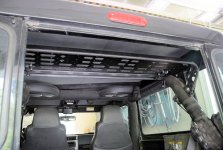
jscherb
Expedition Leader
A few weeks ago I posted that a lithium battery company asked me if I'd like to test one of their batteries - I agreed and it arrived just after Christmas. I installed it today as my auxiliary battery (shown here before I installed the cover):
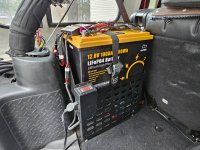
Before installing it I ran a test with just the fridge to see how long the lead-acid would run the fridge in current weather conditions before becoming discharged enough so the fridge wouldn't run. In summer weather, that's usually about 2 1/2 days, but that depends a lot on the exact ambient temperature, how many times the fridge is opened, what's in it, etc. In current temps (50 degrees in the garage and maybe warmer when I'm driving the Jeep with the heat on), the lead-acid stopped running the fridge after about 5 1/2 days. The lithium battery has basically the same amp/hour rating (100 vs 101 for the lead-acid) so we should expect similar performance. I'll let the fridge run on the lithium until it stops, then I'll do a number of other tests and start a detailed thread with a review.
But before I start testing the longevity of the lithium battery, I need to solve a few charging challenges - the lithium battery has more demanding charging parameters than the lead-acid I replaced and it isn't charging fully the way the charging system is currently configured.
Stay tuned.
----
Update on another subject: LED headlights. I've been using Auxbeam LED headlight bulbs in my JKU for about 18 months now, and I've been really happy with them - they're much brighter than the factory headlights. All through last winter we didn't have a snow situation that caused snow buildup on the headlights. Tuesday I had to drive to Newark and back and on the way down it was snowing in the Pocono mountains - a very heavy, wet snow and this is the result:

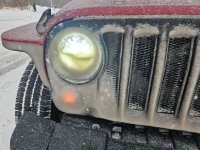
I went all winter last year without enough buildup to seriously impair the headlights so this is the first time this happened. Notice in the second photo that there's buildup all over the grille and on the marker lights, which are incandescent bulbs. Looking at other vehicles on the road that didn't have LED's, there was buildup on their headlights as well, so this was a snow that was heavy and wet enough to impair halogen headlights as well. That doesn't mean LED's are as good as halogens when it comes to resisting snow removal though, the lack of heat generated by LEDs definitely makes them more susceptible to snow buildup.
So what to do? A few options:
1. Do nothing. Having gone all of last winter without a problem and seeing that yesterday's snow was also building up on halogens on other vehicles, maybe the problem isn't worth a lot of effort. And I'll be moving to Delaware before next winter where there's a bit less snow than upstate NY, and anyway Jeep feels that LEDs are good enough without heaters to offer them as an option on JL's.
2. Implement the headlight washer solution I posted about a week or so ago. Easy to implement and low cost.
3. Develop my heater overlay idea. I came up with this last year, the idea is a flexible resistance grid that can be installed over the headlight lens for the winter. It would install using the headlight clamp ring. The resistance elements would be thin enough not to significantly interfere with the headlight beam, think of it like adapting a rear window defroster to a headlight lens and having it be removable in the spring. I've done some work with resistance heating elements on several projects in the past so I know what's required to make this work, I'll just need to source a few materials.
Since I'm very busy with preparing for the move to the new house, prepping the current house for sale, downsizing and getting rid of lots of things here like molds for Jeep parts I'll probably never need to use again, I don't really have time to implement #3 although I think that's the solution I prefer, so I think I'll do #1 for this winter and hopefully have time to develop #3 before next winter. And until then, if a snow like this happens again, it's not too much trouble to stop periodically and wipe the snow off the lenses.

Before installing it I ran a test with just the fridge to see how long the lead-acid would run the fridge in current weather conditions before becoming discharged enough so the fridge wouldn't run. In summer weather, that's usually about 2 1/2 days, but that depends a lot on the exact ambient temperature, how many times the fridge is opened, what's in it, etc. In current temps (50 degrees in the garage and maybe warmer when I'm driving the Jeep with the heat on), the lead-acid stopped running the fridge after about 5 1/2 days. The lithium battery has basically the same amp/hour rating (100 vs 101 for the lead-acid) so we should expect similar performance. I'll let the fridge run on the lithium until it stops, then I'll do a number of other tests and start a detailed thread with a review.
But before I start testing the longevity of the lithium battery, I need to solve a few charging challenges - the lithium battery has more demanding charging parameters than the lead-acid I replaced and it isn't charging fully the way the charging system is currently configured.
Stay tuned.
----
Update on another subject: LED headlights. I've been using Auxbeam LED headlight bulbs in my JKU for about 18 months now, and I've been really happy with them - they're much brighter than the factory headlights. All through last winter we didn't have a snow situation that caused snow buildup on the headlights. Tuesday I had to drive to Newark and back and on the way down it was snowing in the Pocono mountains - a very heavy, wet snow and this is the result:


I went all winter last year without enough buildup to seriously impair the headlights so this is the first time this happened. Notice in the second photo that there's buildup all over the grille and on the marker lights, which are incandescent bulbs. Looking at other vehicles on the road that didn't have LED's, there was buildup on their headlights as well, so this was a snow that was heavy and wet enough to impair halogen headlights as well. That doesn't mean LED's are as good as halogens when it comes to resisting snow removal though, the lack of heat generated by LEDs definitely makes them more susceptible to snow buildup.
So what to do? A few options:
1. Do nothing. Having gone all of last winter without a problem and seeing that yesterday's snow was also building up on halogens on other vehicles, maybe the problem isn't worth a lot of effort. And I'll be moving to Delaware before next winter where there's a bit less snow than upstate NY, and anyway Jeep feels that LEDs are good enough without heaters to offer them as an option on JL's.
2. Implement the headlight washer solution I posted about a week or so ago. Easy to implement and low cost.
3. Develop my heater overlay idea. I came up with this last year, the idea is a flexible resistance grid that can be installed over the headlight lens for the winter. It would install using the headlight clamp ring. The resistance elements would be thin enough not to significantly interfere with the headlight beam, think of it like adapting a rear window defroster to a headlight lens and having it be removable in the spring. I've done some work with resistance heating elements on several projects in the past so I know what's required to make this work, I'll just need to source a few materials.
Since I'm very busy with preparing for the move to the new house, prepping the current house for sale, downsizing and getting rid of lots of things here like molds for Jeep parts I'll probably never need to use again, I don't really have time to implement #3 although I think that's the solution I prefer, so I think I'll do #1 for this winter and hopefully have time to develop #3 before next winter. And until then, if a snow like this happens again, it's not too much trouble to stop periodically and wipe the snow off the lenses.
jscherb
Expedition Leader
Yesterday my JKU passed a milestone... 300k miles. It's salt-encrusted right now because it's been doing a lot of miles in the last 2 weeks towing the trailer to and from my new house 4 hours away, but it does cleans up very nicely and when it's clean you'd never think it has that many miles on it.
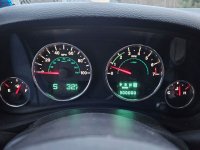
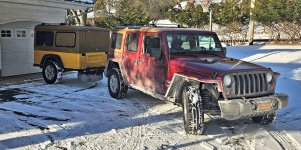
One of the reasons for my trip was a meeting with Quadratec along with Overland Outfitters. The agenda included the state of the Jeep accessories market, OO's sales through QT, upcoming promotions of OO products on QT, etc. One of the promotions is OO's inclusion in QT's 3-stage giveaway build; we visited QT video host Rob Jarrell in his shop and I took these photos - the OO tailgate panel plus Grab & Go bags and OO's SpareSide bags. There are about a half dozen OO products included in the 3 stages of the build and all will go to the winner of the Jeep, which will be done by drawing. More on the build and the drawing: https://www.quadratec.com/jeep-vehicle-giveaway
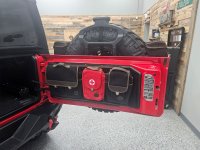
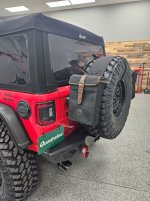


One of the reasons for my trip was a meeting with Quadratec along with Overland Outfitters. The agenda included the state of the Jeep accessories market, OO's sales through QT, upcoming promotions of OO products on QT, etc. One of the promotions is OO's inclusion in QT's 3-stage giveaway build; we visited QT video host Rob Jarrell in his shop and I took these photos - the OO tailgate panel plus Grab & Go bags and OO's SpareSide bags. There are about a half dozen OO products included in the 3 stages of the build and all will go to the winner of the Jeep, which will be done by drawing. More on the build and the drawing: https://www.quadratec.com/jeep-vehicle-giveaway


jscherb
Expedition Leader
Anyone here have a Bronco or have a friend with a Bronco?
Two months ago I took a MORryde Trail Kitchen no-drill installation kit for the JL down to the Ford dealer and asked them if I could set the parts in place to do some measurements to see what changes would be required to the kit for it to mount in a Bronco...

I sent MORryde a drawing showing the necessary changes and yesterday they called to tell me they've got a prototype through engineering and production and now they're looking for someone with a Bronco who is willing to install it in their Bronco, test it and provide feedback to MORryde. MORryde will provide a prototype no-drill installation kit and a Trail Kitchen so a full installation can be tested and the tester can keep whatever MORryde provides. I'm going to post this on a Bronco forum but I thought I'd try here first to see if anyone here might be able to help.
Two months ago I took a MORryde Trail Kitchen no-drill installation kit for the JL down to the Ford dealer and asked them if I could set the parts in place to do some measurements to see what changes would be required to the kit for it to mount in a Bronco...

I sent MORryde a drawing showing the necessary changes and yesterday they called to tell me they've got a prototype through engineering and production and now they're looking for someone with a Bronco who is willing to install it in their Bronco, test it and provide feedback to MORryde. MORryde will provide a prototype no-drill installation kit and a Trail Kitchen so a full installation can be tested and the tester can keep whatever MORryde provides. I'm going to post this on a Bronco forum but I thought I'd try here first to see if anyone here might be able to help.
jscherb
Expedition Leader
I've posted photos of my suction-mount trail table before; MORryde has picked up the design and they're working on finalizing their version of the design for production.
The suction mounts I originally used were 5" in diameter; now I'm testing it with 3" mounts which are rated for 55 lbs. each.
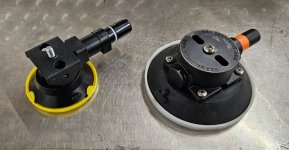
Testing in below zero temperatures today:
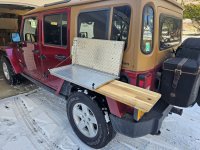
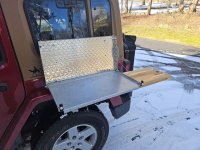
They seem to work pretty well.
The suction mounts I originally used were 5" in diameter; now I'm testing it with 3" mounts which are rated for 55 lbs. each.

Testing in below zero temperatures today:


They seem to work pretty well.
jscherb
Expedition Leader
For all the years I've had these bags on the back of my JKU and LJ I've taken them through the car wash - either the self-wash, where I would use the pressure wand on them, or the automatic wash, where I'd tell the attendant to pressure wash them, aiming down so the spray doesn't go up into the bag. I've got a bunch of uses for a pressure washer so I bought one today and the first thing I tested it on was my SpareHopper and SpareSide bags - they were coated with winter road salt.
I don't think I'd subject any of the other bags on the market to a 2200 psi pressure wash, but these like it just fine.

I don't think I'd subject any of the other bags on the market to a 2200 psi pressure wash, but these like it just fine.

jscherb
Expedition Leader
About once a year I need to use the JKU for more than three passengers, which means that the floor compartment has to be swapped out for the 2/3 side of the rear seat to go in. The floor compartment:

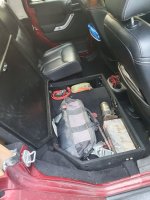
I designed the floor compartment so it's relatively easy to swap it for the seat, the hardest part is the awkward size and shape of the rear seat and getting it from where I store it back into the Jeep by myself. The swap doesn't take too long and in two weeks I'll swap the compartment back in because that's way more useful to me than a fourth seat.
The reason this time is my sister Sue. She and her husband do several national parks each year and next week they're doing Arches National Park in Moab. Also at the end of next week Overland West starts on Friday, which I usually attend each year, so we're heading out early to meet up with Sue and Glen in Moab the beginning of the week. We'll do some trails in the JKU (hence the need for 4 seats), and after a few days well leave them and head on to Flagstaff for Overland West. Sue and Glen have never done any off-roading, so we thought it would be fun to introduce them to the experience. I've got a few fairly easy trails planned, enough to give them a good experience but not so tough as to risk the rest of the trip.
I also put the kitchen back in for the trip. It's very easy to install/remove, so I only have it in the Jeep when I have a need for it. We'll use it for meals on the trails in Utah and for meals at Overland West. I keep the kitchen in the garage on a Harbor Freight cart that's about the same height as the floor of the Jeeps. I roll it up to the back of the Jeep and slide the kitchen off the cart and into the Jeep, no lifting required. It secures to the floor with three bolts, and I use studs in place of bolts to align it - it's easy to slide the kitchen in place, dropping the holes in the base over the studs. Then I remove the studs and put the bolts in place, easy to do because the studs lined up the holes.

I'll post photos from Moab and from Overland West, stay tuned.


I designed the floor compartment so it's relatively easy to swap it for the seat, the hardest part is the awkward size and shape of the rear seat and getting it from where I store it back into the Jeep by myself. The swap doesn't take too long and in two weeks I'll swap the compartment back in because that's way more useful to me than a fourth seat.
The reason this time is my sister Sue. She and her husband do several national parks each year and next week they're doing Arches National Park in Moab. Also at the end of next week Overland West starts on Friday, which I usually attend each year, so we're heading out early to meet up with Sue and Glen in Moab the beginning of the week. We'll do some trails in the JKU (hence the need for 4 seats), and after a few days well leave them and head on to Flagstaff for Overland West. Sue and Glen have never done any off-roading, so we thought it would be fun to introduce them to the experience. I've got a few fairly easy trails planned, enough to give them a good experience but not so tough as to risk the rest of the trip.
I also put the kitchen back in for the trip. It's very easy to install/remove, so I only have it in the Jeep when I have a need for it. We'll use it for meals on the trails in Utah and for meals at Overland West. I keep the kitchen in the garage on a Harbor Freight cart that's about the same height as the floor of the Jeeps. I roll it up to the back of the Jeep and slide the kitchen off the cart and into the Jeep, no lifting required. It secures to the floor with three bolts, and I use studs in place of bolts to align it - it's easy to slide the kitchen in place, dropping the holes in the base over the studs. Then I remove the studs and put the bolts in place, easy to do because the studs lined up the holes.

I'll post photos from Moab and from Overland West, stay tuned.
jscherb
Expedition Leader
I've stopped overnight near the Denver Airport because while I drove here from Delaware, my better half had more important things to do than sit in the Jeep for two days so she's flying out tonight. Tomorrow we'll head for the Glenwood Hot Springs Lodge, then Moab for a few days showing my sister and her husband what offroading is like, then on to Flagstaff for Overland West.
Spotted this on a JK in the hotel parking lot:
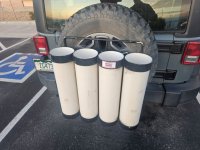
I have no idea what it might be for, so I'm posting a photo to see if someone else has a clue.
Spotted this on a JK in the hotel parking lot:

I have no idea what it might be for, so I'm posting a photo to see if someone else has a clue.
